
The post 9 Brown Snakes In North Carolina appeared first on A-Z Animals.
With stunning mountain ranges, flat coastal plains, and the rolling fields of the Piedmont plateau region, North Carolina has a vast array of habitats that are home to thousands of different animals. Amongst these animals are snakes, and there are 37 species that call the state home, of which six are venomous. While snakes often come in many bright and vibrant colors and patterns, some of them use their appearance to keep themselves hidden. Quite possibly, the best-camouflaged snakes are brown snakes which can hide amongst leaf litter and soil and underneath logs and rocks. In fact, some blend in so well you might not even notice them, so join us as we discover some of the brown snakes in North Carolina!
This post was updated on October 19, 2025 to clarify the length of the cottonmouth, brown snake coloring, eastern diamond back maximum size and range, abundance of mole kingsnakes in the coastal plain, rarity of pine woods snake in North Carolina, and pine snake elevations.

North Carolina has a vast array of habitats that are home to thousands of different animals.
©iStock.com/albertc111
Cottonmouth Snake
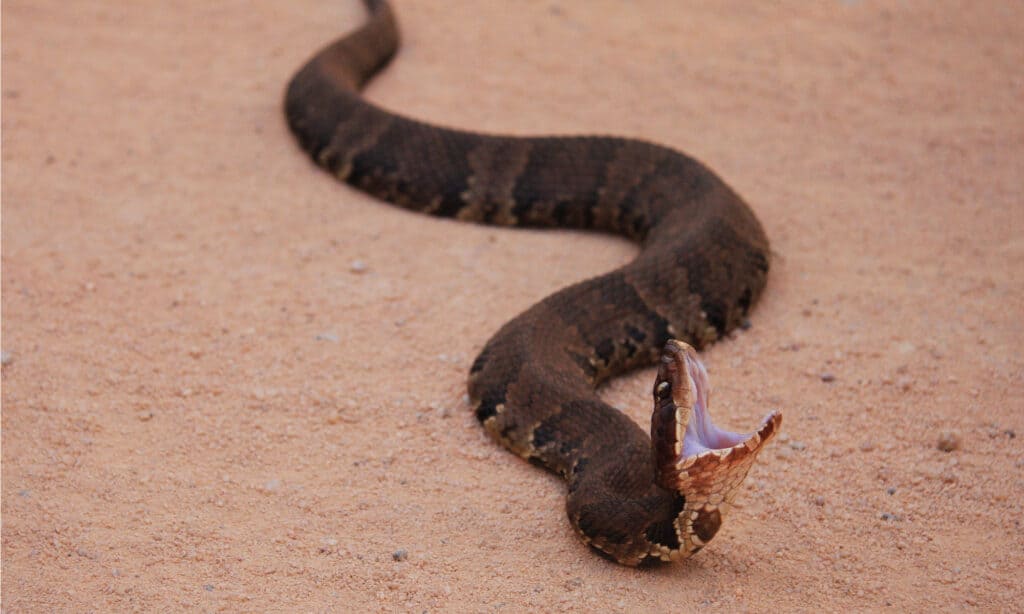
Cottonmouths are semi-aquatic and often live in shallow bodies of water.
©Nathan A Shepard/Shutterstock.com
Also known as water moccasins, cottonmouths are one of the most venomous pit vipers. Most adult cottonmouths in NC range 2.5–4 ft; though individuals can reach 6 ft, they are exceptionally rare. Males larger than females. Cottonmouths are usually black with dark brown crossband markings and cream or tan bellies. The crossbands are sometimes broken, creating half-band markings on either side of their bodies. Cottonmouths are semi-aquatic snakes and live in shallow streams, ponds, and swamps. However, they rarely occur in deeper bodies of water. Despite this, they can also sometimes occur up to one mile from water in forests and prairies. Cottonmouths are active both during the night and the day, and they feed on a wide range of birds, snakes, fish, amphibians, and mammals. They usually stand their ground rather than fleeing when threatened and vibrate their tail as a warning.
Brown Water Snake
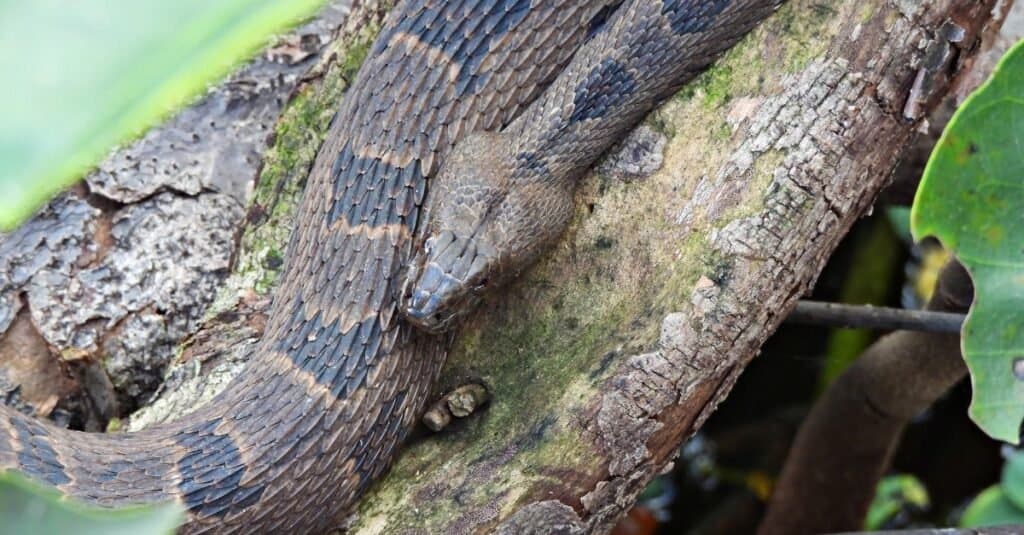
Brown water snakes have a similar appearance to venomous cottonmouths.
©iStock.com/passion4nature
The most common species of water snake throughout the southeastern US is the brown water snake. Brown water snakes live mainly in swamps and streams in lower coastal regions in North Carolina, where they feed predominantly on juvenile catfish. They are almost completely brown, with the exception of around 25 black or dark brown markings down their back (and their belly is yellowish with dark blotches). They have thick, heavy bodies and large, flat heads. However, their neck is noticeably narrower than their head. Brown water snakes are also mistaken as water moccasins due to their resemblance to cottonmouths, and many are killed every year as a result. Brown water snakes can bite when threatened, but they are not venomous or seriously dangerous to humans.
Eastern Diamondback Rattlesnake
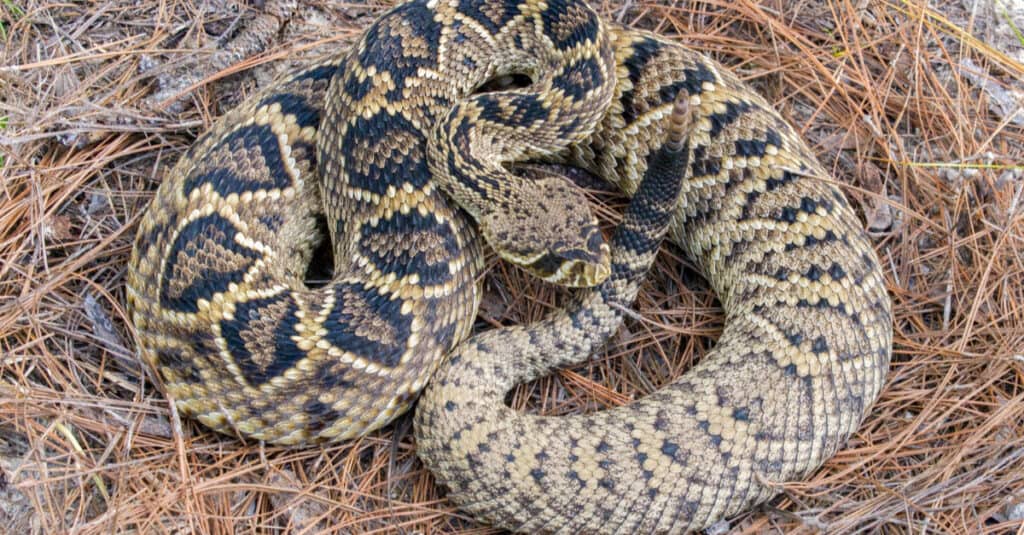
Eastern diamondback rattlesnakes’ pattern often fades towards their tail.
©Chase D'animulls/Shutterstock.com
While the eastern diamondback historically ranged into southeastern North Carolina, it is now considered extirpated or extremely rare there. Since their presence in the state is debated, we’re including them here. These are the largest rattlesnakes in the world and can reach 6 feet long, although a record of 8 ft 3 in has been observed. Eastern diamondback rattlesnakes have brownish bodies which are overlaid with diamonds. The diamond markings are usually black or brown but have cream-colored borders and become crossbands nearer the tail. Eastern diamondbacks live in woodlands, forests, and swamps, and they often inhabit the burrows of gopher tortoises. They are ambush predators and feed mainly on birds, rodents, and other small mammals. Eastern diamondbacks are incredibly dangerous as they have the largest fangs of any rattlesnake and contain a high amount of venom – enough to kill five adults. Thankfully though, they don’t have a particularly aggressive nature!
Mole Kingsnake
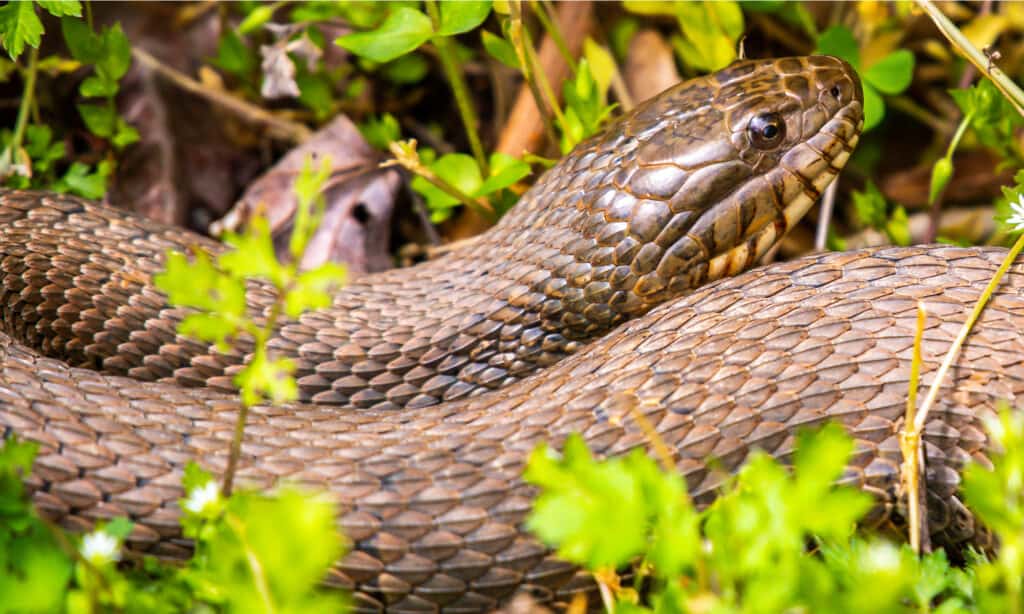
Mole Kingsnake’s pattern fades as they get older.
©Krumpelman Photography/Shutterstock.com
An incredibly secretive snake is the mole kingsnake (Lampropeltis rhombomaculata). Mole kingsnakes are 30 to 42 inches long and are typically light brown with reddish-brown spots down their bodies. However, these spots fade as the snake becomes older, so it is common for the oldest snakes to have no markings at all. Mole kingsnakes prefer to live in fields on the edge of forests where there is plenty of loose soil for them to burrow into. They are particularly abundant in the Coastal Plain and Piedmont region. Mole kingsnakes are oviparous, meaning they lay eggs that hatch outside of the body – like birds. Females lay 10 to 12 eggs underground and then leave them to hatch on their own. Mole kingsnakes are not venomous and prey on rodents, lizards, and frogs.
Rough Earth Snake
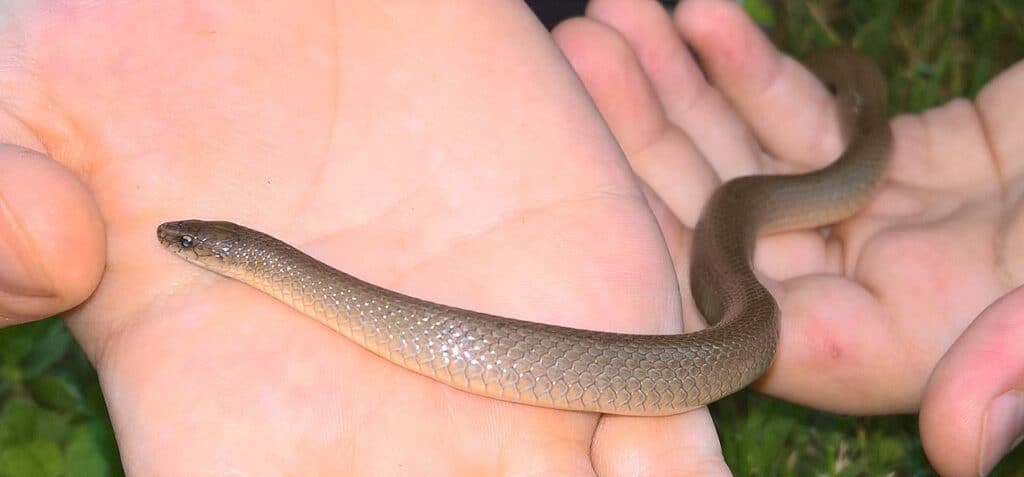
Rough earth snakes are typically brown with white or yellowish bellies.
One of the smallest brown snakes in North Carolina is the rough earth snake at only 7 to 10 inches long. Rough earth snakes have slender bodies and are typically brown or reddish-brown with no markings on them. They have keeled dorsal scales, which give them a rough texture and help to distinguish them from smooth earth snakes. Rough earth snakes live in both forests and urban areas, where they are one of the most abundant snakes. In both habitats, they prefer to hide away underneath logs and rocks or burrow into loose soil or leaf litter. They mainly eat earthworms, and they have many predators due to their small size. Rough earth snakes are completely harmless to humans and very rarely – if ever – bite.
Pine Woods Snake
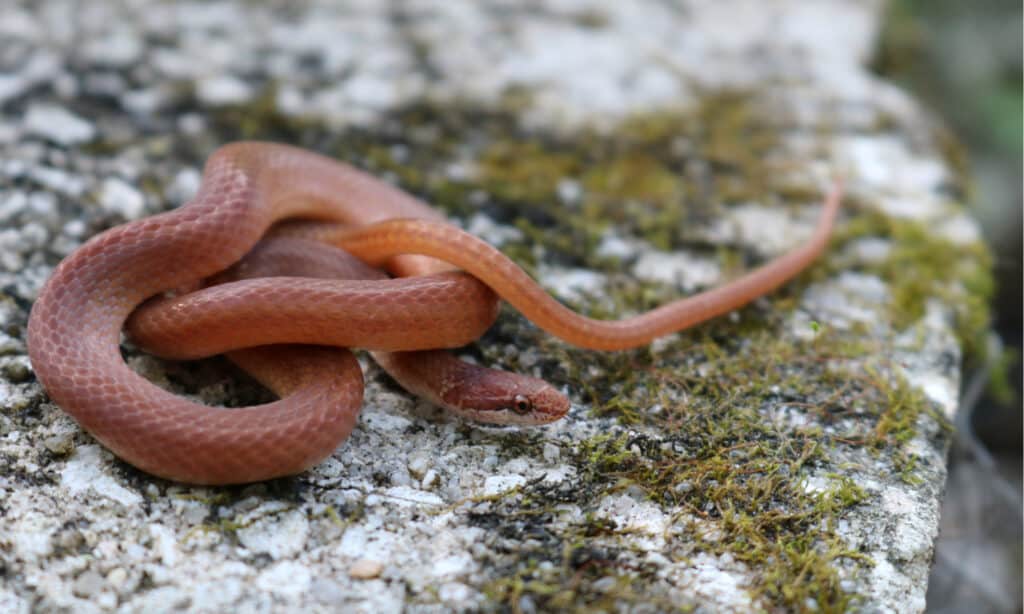
Pine woods snakes live in forests where they can blend in with the leaf litter.
©Andrew Jeffries/Shutterstock.com
Also known as the brown-headed snake, pine woods snakes are 10 to 13 inches long and reddish-brown. Pine woods snakes (Rhadinaea flavilata) live in damp woodlands and pine forests in scattered coastal regions across North Carolina. They are secretive snakes and often hide in leaf litter or underneath logs. During the winter, they typically hibernate underground. Pine woods snakes have a small set of fangs at the rear of their mouth and are mildly venomous to their prey, though not to humans. Their diet consists of frogs, lizards, and salamanders. They have several predators, including other snakes such as kingsnakes and southern black racers. Recent sources (e.g., AmphibiaWeb, iNaturalist) list this snake as rare in NC — confined to the southeastern Coastal Plain and considered of conservation concern.
Southeastern Crown Snake
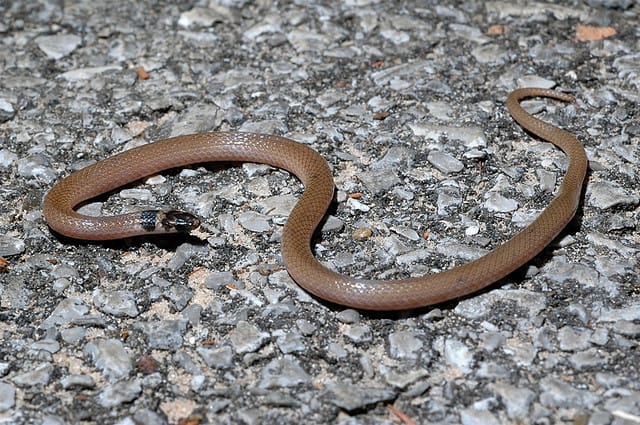
Southeastern crown snakes are not aggressive toward humans.
Another small snake is the southeastern crown snake which is 8 to 10 inches long. Southeastern crown snakes are endemic to the southeastern region of the United States and are light brown or grayish-brown with black heads. Present in most of NC except higher elevations, these snakes thrive in woodland habitats in areas where there is loose and sandy soil and plenty of leaf litter for them to burrow into when they are threatened. Although they are not harmful to humans, southeastern crown snakes are mildly venomous to their prey and possess a set of small rear fangs with which to inject it. Their diet mainly consists of small prey such as worms, spiders, and centipedes. They have numerous predators, although their main ones are coral snakes and kingsnakes.
Pine Snake
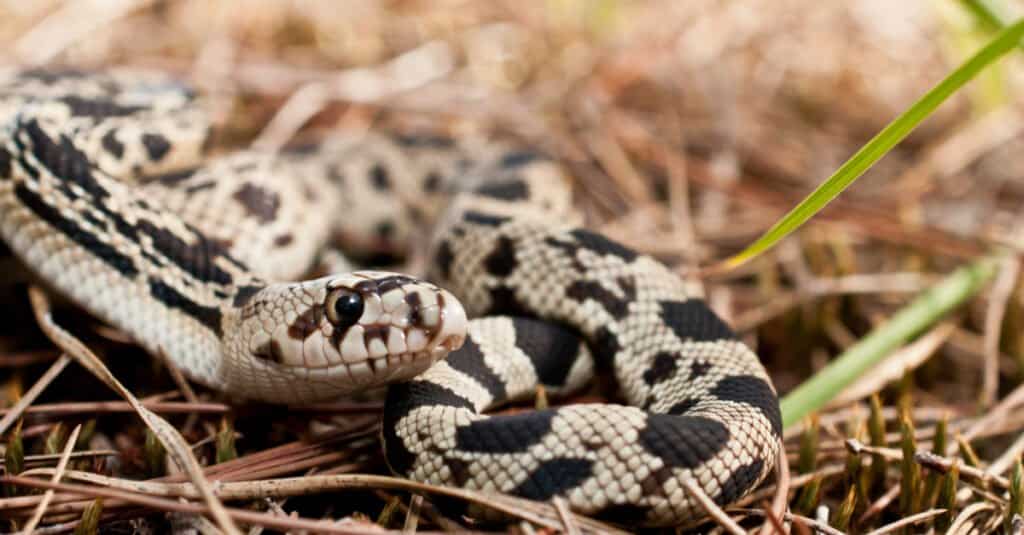
The spots on a pine snake are generally darker toward the head and lighter toward the tail.
©Jay Ondreicka/Shutterstock.com
There are three recognized subspecies of pine snakes, all of which are endemic to the southeastern US. Pine snakes (Pituophis melanoleucus) are 48 to 90 inches long and have small heads with powerful bodies. They are usually brown or grayish-brown with brown or black blotches. Pine snakes live in a range of habitats. In western states, they may reside at elevations as high as 9,000 feet. However, In NC, pine snakes occur mostly in Coastal Plain sandhills and the lower Piedmont. Their preferred habitats are pine flatwoods and woodlands as well as prairies and fields with plenty of sandy soil for them to lay their eggs. Pine snakes are not venomous but vibrate their tail as a warning before striking when they are threatened. Their diet mainly consists of rodents, and they often enter rodent burrows in search of food. The main predators of pine snakes are foxes and skunks.
Eastern Copperhead
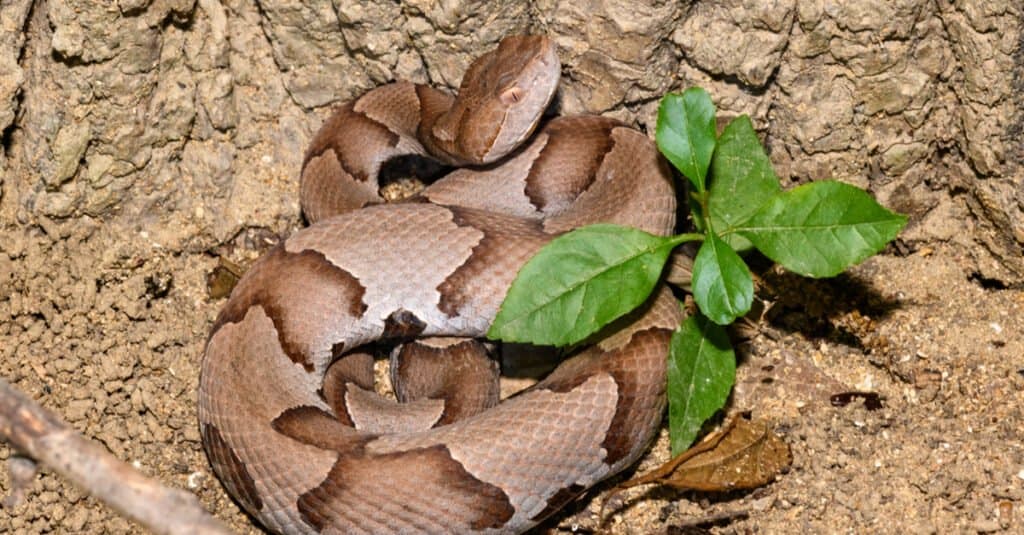
Eastern copperheads are often stood on as they blend in with the forest floor.
©Jeff W. Jarrett/Shutterstock.com
Another venomous brown snake in North Carolina is the eastern copperhead. Eastern copperheads are 22 to 36 inches long and are pinkish-tan with darker crossband markings. The markings along their back typically appear as an hourglass pattern, while those on their sides usually have light centers. Eastern copperheads prefer to live in deciduous forests, woodlands, and swamps. Their appearance provides them with excellent camouflage amongst leaves and makes them incredibly difficult to spot. As they usually freeze when disturbed rather than fleeing, they are often unwittingly stood on, which is when they are most likely to bite. However, their venom is fairly weak. Eastern copperheads are nocturnal during the summer months but are active during the day in spring and fall. In the winter, they may hibernate in dens. Though copperheads are not social hibernators by choice, they do occasionally share hibernacula with other species such as timber rattlesnakes or rat snakes.
Where Do These Snakes Live?
It all depends on their species. Some like cottonmouths and eastern diamondbacks prefer shallow water but can live on land. Others like copperheads share brown water snakes’ fondness for swamps although they are also fond of woodlands and forests.
Pinesnakes on the other hand are even more varied in their choice of habitat, but are generally partial to places with plenty of sandy soil. The same goes for southeastern crown snakes, although they prefer their sandy soil mixed in with a bit of leaf litter. Pinewood snakes love pine forests due to the abundance of logs and leafy matter for them to burrow into.

The post 9 Brown Snakes In North Carolina appeared first on A-Z Animals.
October 19, 2025 at 06:32PMHannah Ward
.jpeg)
.jpeg)

0 Comments